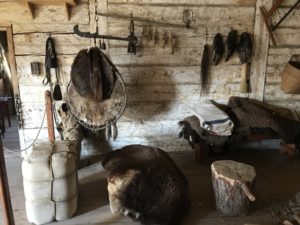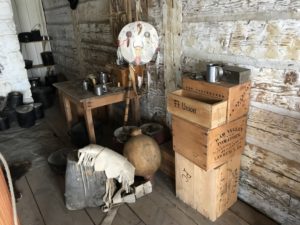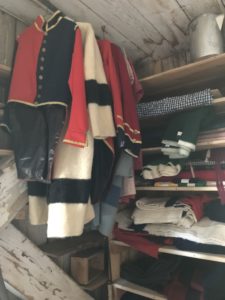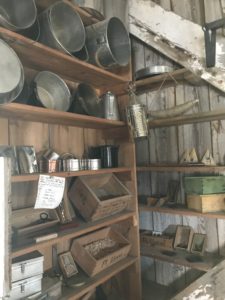One of the places that Tom and I both enjoy working at Fort Union Trading Post is the Trade House. Tom gets assigned there once a week. I get assigned once every two weeks but I often cover the building for lunches and breaks.
The Trade House is the most important building at Fort Union Trading Post National Historic Site because it is where the trade happened. When a tribe would come to Fort Union, the chief and his delegation would be met by a trader and an interpreter in the Trade House. They would have a long ceremony of respect together, eating, drinking, and sharing stories and gifts. After catching up and smoking a peace pipe, the men would get down to the business negotiations.
Some modern people think the Native Americans were naïve when it came to trade with the Euro-Americans. They were not. After all, the Assiniboine tribe invited the traders to build in this location. The tribe knew the advantage to having a general store in their community. Because of their extensive trade network, the Native Americans already knew how to tell good quality items from cheap trinkets. They inspected the nap and thickness of blankets and checked the welds on pots. If items were not good quality, the Native Americans took their trade elsewhere.
The value of the furs varied from year to year and tribe to tribe. Winter furs were worth more than summer furs because they were thicker. If a tribe had traded with the post for many years or a trader had married into the family, they would get a more generous deal. A tribe trading for the first time would get a bonus to entice them to come back again. After the chief negotiated the value of the furs for his tribe, individual tribal members would come to the Trade House with their furs and their shopping lists.
One section of our Trade House has representative goods used in the fur trade. There are blankets, jewelry, pots and pans, guns, ammunition, matches, tobacco, shirts, coats, and yards of fabric. Textiles were the #1 most traded item. Shirts wore out faster than a gun or a kettle. Furs from Fort Union Trading Post were sent all over the world: China, Russia, Europe, and all over the United States. Goods from all those places were shipped to St. Louis, and from St. Louis sent up the Missouri River to Fort Union.
Up until 1832, the most valuable furs were beaver. Around that year fashions started to change and buffalo furs became more valuable. That is also the year that paddleboats started coming up the river, lowering shipping costs on the bulky buffalo furs. Fort Union shipped out between 20,000 and 30,000 buffalo furs annually for close to 30 years. This trade provided a good living for the fur traders as well as the Native Americans who brought the furs.
When we are working in the Trade House, we wear our historical clothing and interpret the story of the trade happening between the Native Americans and the Euro-Americans. People have lots of interesting questions about artifacts, trade items, and furs. We try to get people to start their tour of Fort Union Trading Post in the Trade House because it helps them understand the purpose of the trading post.

I also like working in the Trade House because, when we don’t have any visitors, I can play my Native American flute or do some fingerweaving. When Tom is in the Trade House he braids leather. Karl plays his concertina. All of these things help us practice some historic skills while also keeping us occupied between guests. The day goes quickly when we work in the Trade House.




